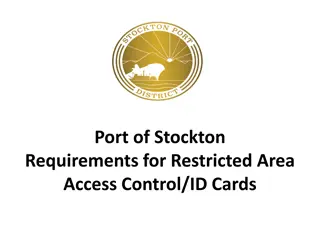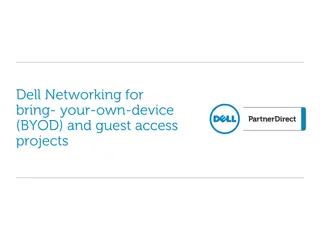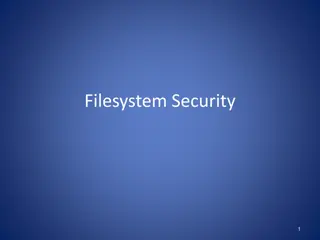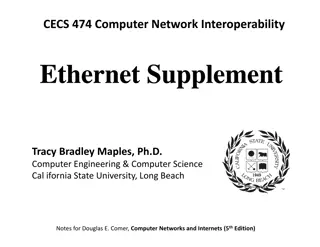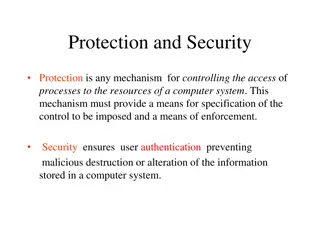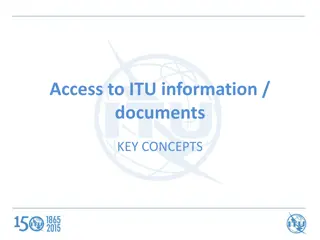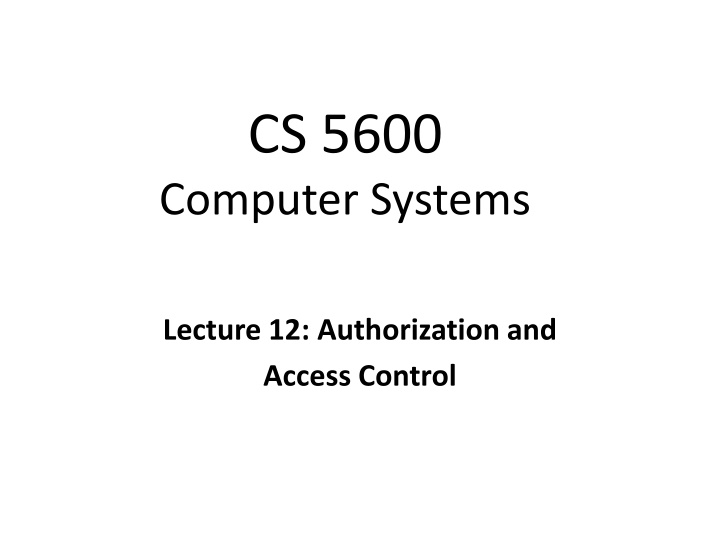
Authorization and Access Control in Computer Systems
Learn about the importance of authentication, access control, and types of secrets in computer systems. Explore the risks of storing passwords in plain text and the solution of using hashed passwords for security. Understand how one-way cryptographic hash functions work to protect user credentials effectively.
Download Presentation

Please find below an Image/Link to download the presentation.
The content on the website is provided AS IS for your information and personal use only. It may not be sold, licensed, or shared on other websites without obtaining consent from the author. If you encounter any issues during the download, it is possible that the publisher has removed the file from their server.
You are allowed to download the files provided on this website for personal or commercial use, subject to the condition that they are used lawfully. All files are the property of their respective owners.
The content on the website is provided AS IS for your information and personal use only. It may not be sold, licensed, or shared on other websites without obtaining consent from the author.
E N D
Presentation Transcript
CS 5600 Computer Systems Lecture 12: Authorization and Access Control
Authentication Access Control Mandatory Access Control 2
Authentication Authentication is the process of verifying an actor s identity Critical for security of systems Permissions, capabilities, and access control are all contingent upon knowing the identity of the actor Typically parameterized as a username and a secret The secret attempts to limit unauthorized access 4
Types of Secrets Actors provide their secret to log-in to a system Three classes of secrets: 1. Something you know Example: a password 2. Something you have Examples: a smart card or smart phone 3. Something you are Examples: fingerprint, voice scan, iris scan 5
Checking Passwords The system must validate passwords provided by users Thus, passwords must be stored somewhere Basic storage: plain text password.txt cbw sandi amislove bob p4ssw0rd i heart doggies 93Gd9#jv*0x3N security 6
Problem: Password File Theft Attackers often compromise systems They may be able to steal the password file Linux: /etc/shadow Windows: c:\windows\system32\config\sam If the passwords are plain text, what happens? The attacker can now log-in as any user, including root/administrator Passwords should never be stored in plain text 7
Hashed Passwords Key idea: store encrypted versions of passwords Use one-way cryptographic hash functions Examples: md5, sha1, sha256, sha512 Cryptographic hash function transform input data into scrambled output data Deterministic: hash(A) = hash(A) High entropy: md5( security ) = e91e6348157868de9dd8b25c81aebfb9 md5( security1 ) = 8632c375e9eba096df51844a5a43ae93 md5( Security ) = 2fae32629d4ef4fc6341f1751b405e45 Collision resistant Locating A such that hash(A) = hash(A ) takes a long time Example: 221 tries for md5 8
Hashed Password Example md5( p4ssw0rd ) = 2a9d119df47ff993b662a8ef36f9ea20 User: cbw md5( 2a9d119df47ff993b662a8ef36f9ea20 ) = b35596ed3f0d5134739292faa04f7ca3 hashed_password.txt cbw sandi amislove bob 2a9d119df47ff993b662a8ef36f9ea20 23eb06699da16a3ee5003e5f4636e79f 98bd0ebb3c3ec3fbe21269a8d840127c e91e6348157868de9dd8b25c81aebfb9 9
Attacking Password Hashes Recall: cryptographic hashes are collision resistant Locating A such that hash(A) = hash(A ) takes a very long time Are hashed password secure from cracking? No! Problem: users choose poor passwords Most common passwords: 123456, password Username: cbw, Password: cbw Weak passwords enable dictionary attacks 10
Dictionary Attacks English Dictionary List of possible password hashes hashed_ password.txt Common Passwords Common for 60-70% of hashed passwords to be cracked in <24 hours 11
Hardening Password Hashes Key problem: cryptographic hashes are deterministic hash( p4ssw0rd ) = hash( p4ssw0rd ) This enables attackers to build lists of hashes Solution: make each password hash unique Add a salt to each password before hashing hash(salt + password) = password hash Each user has a unique, random salt Salts can be stores in plain text 12
Example Salted Hashes hashed_password.txt cbw sandi amislove bob 2a9d119df47ff993b662a8ef36f9ea20 23eb06699da16a3ee5003e5f4636e79f 98bd0ebb3c3ec3fbe21269a8d840127c e91e6348157868de9dd8b25c81aebfb9 hashed_and_salted_password.txt cbw sandi amislove bob a8 0X hz K@ af19c842f0c781ad726de7aba439b033 67710c2c2797441efb8501f063d42fb6 9d03e1f28d39ab373c59c7bb338d0095 479a6d9e59707af4bb2c618fed89c245 13
Password Storage on Linux /etc/passwd username:x:UID:GID:full_name:home_directory:shell cbw:x:1001:1000:Christo Wilson:/home/cbw/:/bin/bash amislove:1002:2000:Alan Mislove:/home/amislove/:/bin/sh First two characters are the salt /etc/shadow username:password:last:may:must:warn:expire:disable:reserved cbw:a8ge08pfz4wuk:9479:0:10000:::: amislove:hz560s9vnalh1:8172:0:10000:::: 14
Attacking Salted Passwords No matches List of possible password hashes hashed_ and_salted_ password.txt hash() cbw sandi amislove hz bob a8 0X List of possible password hashes w/ salt a8 hashes w/ salt 0X K@ List of possible password cbw sandi YYYY XXXX hash( a8 + word) hash( 0X + word) 15
Breaking Hashed Passwords Stored passwords should always be salted Forces the attacker to brute-force each password individually Problem: it is now possible to compute cryptographic hashes very quickly GPU computing: hundreds of small CPU cores nVidia GeForce GTX Titan Z: 5,760 cores GPUs can be rented from the cloud very cheaply 2x GPUs for $0.65 per hour (2014 prices) 16
Examples of Hashing Speed A modern x86 server can hash all possible 6 character long passwords in 3.5 hours Upper and lowercase letters, numbers, symbols (26+26+10+32)6 = 690 billion combinations A modern GPU can do the same thing in 16 minutes Most users use (slightly permuted) dictionary words, no symbols Predictability makes cracking much faster Lowercase + numbers (26+10)6 = 2B combinations 17
Hardening Salted Passwords Problem: typical hashing algorithms are too fast Enables GPUs to brute-force passwords Solution: use hash functions that are designed to be slow Examples: bcrypt, scrypt, PBKDF2 These algorithms include a work factor that increases the time complexity of the calculation scrypt also requires a large amount of memory to compute, further complicating brute-force attacks 18
bcrypt Example Python example; install the bcrypt package [cbw@ativ9 ~] python >>> import bcrypt >>> password = my super secret password >>> fast_hashed = bcrypt.hashpw(password, bcrypt.gensalt(0)) >>> slow_hashed = bcrypt.hashpw(password, bcrypt.gensalt(12)) >>> pw_from_user = raw_input( Enter your password: ) >>> if bcrypt.hashpw(pw_from_user, slow_hashed) == slow_hashed: print It matches! You may enter the system else: print No match. You may not proceed Work factor 19
Password Storage Summary 1. Never store passwords in plain text 2. Always salt and hash passwords before storing them 3. Use hash functions with a high work factor These rules apply to any system that needs to authenticate users Operating systems, websites, etc. 20
Password Recovery/Reset Problem: hashed passwords cannot be recovered Hi I forgot my password. Can you email me a copy? Kthxbye This is why systems typically implement password reset Use out-of-band info to authenticate the user Overwrite hash(old_pw) with hash(new_pw) Be careful: its possible to crack password reset 21
Authentication Access Control Mandatory Access Control 22
Status Check At this point, we can authenticate users And we are securely storing their password How do we control what users can do, and what they can access? 23
Simple Access Control Basic security in an OS is based on access control Simple policies can be written as an access control matrix Specifies actions that actors can take on objects Unix actions: read, write and execute For directories, x traverse file 1 file 2 dir 1 file 3 user 1 --- user 2 r-- user 3 r-- r-- r-- r-- --- rwx --- rw- r-- --- user 4 rw- rwx --- --- 24
Users and Groups on Unix Actors are users, each user has a unique ID Users also belong to >=1 groups /etc/passwd cbw:x:13273:65100:Christo Wilson:/home/cbw/:/bin/bash [cbw@finalfight ~] id cbw uid=13273(cbw) gid=65100(faculty) groups=65100(faculty), 1314(cs5700f13),1316(cs5750f13),1328(cs5600sp13) 25
File Permissions on Unix Files and directories have an owner and a group Three sets of permissions: 1. For the owner 2. For members of the group 3. For everybody else (other) [cbw@finalfight ~] ls -lh -rw-r--r-- 1 cbw faculty 244K Mar 2 13:01 pintos.tar.gz drwxr-xr-- 3 cbw faculty 4.0K Mar 2 13:01 pintos Owner Group Global permissions Group permissions Owner permissions 26 File or directory?
Permission Examples [cbw@finalfight ~] ls -lh -rw-r--r-- 1 cbw faculty 244K Mar 2 13:01 pintos.tar.gz drwxr-xr-- 3 cbw faculty 4.0K Mar 2 13:01 pintos cbw:faculty May read both objects May modify the file May not execute the file May enter the directory May add files to the directory May modify the permissions of both objects amislove:faculty May read both objects May not modify the file May not execute the file May enter the directory May not add files to the directory May not modify permissions bob:student May read both objects May not modify the file May not execute the file May not enter the directory May not add files to the directory May not modify permissions 27
Encoding the Access Control Matrix file 1 file 2 dir 1 file 3 user 1 --- r-- --- rw- group 1 = {user 2, user 3, user 4} group 2 = {user 1, user 2} user 2 r-- r-- rwx r-- user 3 r-- user 4 rw- r-- rwx --- --- --- --- file 1 owner = user 4, group = group 1, rw-r----- file 2 owner = user 4, group = group 1, rwx---r-- dir 1 owner = user 2, group = group 1, rwx------ file 3 owner = user 1, group = group 2, rw-r----- 28
Modifying Permissions u user g group o - other = set permissions + add permissions - remove permissions r read w write x - executable Users may only modify the permissions of files they own [cbw@finalfight ~] ls -lh -rw------- 1 amislove faculty 5.1K Jan 23 11:25 alans_file -rw------- 4 cbw faculty 3.5K Jan 23 11:25 christos_file [cbw@finalfight ~] chmod ugo+rw alans_file chmod: changing permissions of `alans_file': Operation not permitted [cbw@finalfight ~] chmod go+r christos_file [cbw@finalfight ~] chmod u+w christos_file [cbw@finalfight ~] chmod u-r christos_file [cbw@finalfight ~] ls -lh -rw------- 1 amislove faculty 5.1K Jan 23 11:25 alans_file --wxr--r-- 4 cbw faculty 3.5K Jan 23 11:25 christos_file 29
Advanced chmod Sometimes you ll see chmod commands in numerical format [cbw@finalfight ~] chmod 755 christos_file What do the numbers mean? Permissions (rwx) are stored in binary (000) Example: rw- is 110, or 6 Three permission groups, hence three number Examples: 777 rwxrwxrwx 755 rwxr-x-r-x 644 rw-r--r-- 655 rw-r-xr-x 30
Modifying Users and Groups [cbw@finalfight ~] id cbw uid=13273(cbw) gid=65100(faculty) groups=65100(faculty), 1314(cs5700f13),1316(cs5750f13),1328(cs5600sp13) [cbw@finalfight ~] ls -lh -rw------- 4 cbw faculty 3.5K Jan 23 11:25 christos_file [cbw@finalfight ~] chown cbw:cs5600sp13 christos_file [cbw@finalfight ~] ls -lh -rw------- 4 cbw cs5600sp13 3.5K Jan 23 11:25 christos_file Users may not change the owner of a file* Even if they own it Users may only change to a group they belong to * unless you are root 31
Permissions of Processes Processes also have permissions They have to, since they read files, etc. What is the user:group of a process? 1. The user:group of the executable file? 2. The user:group of the user running the process? Processes inherit the credentials of the user who runs them Child processes inherit their parents credentials * * except when the program is setuid 32
Privileged Operations Other aspects of the OS may also require special privileges Fortunately, on Unix most aspects of the system are represented as files E.g. /dev contains devices like disks Formatting a disk requires permissions to /dev/sd* Processes may only signal other processes with the same user ID* Otherwise, you could send SIGKILL to other user s processes * unless the process is root 33
The Exception to Every Rule On Unix, the root user (ID=0) can do whatever it wants Access any file Change any permission On Windows, called the Administrator account Your everyday user account should never be Admin/root 34
Ways to Access Root Suppose you need to run a privileged command Example: $ apt-get install python How can you get root privileges? 1. Log in as root $ ssh root@mymachine.ccs.neu.edu 2. The Switch User command (su) $ su Opens a new shell with as root:root 3. The Switch User Do Command (sudo) $ sudo apt-get install python Runs the given command as root:root 35
Set Effective User ID In some cases, you may need a program to run as the file owner, not the invoking user Imagine a command-line guessing game Users may input numbers as guesses The user should not be able to read the file with the correct answers Program must check if guesses are correct The program must be able to read the file with correct answers 37
setuid example Game executable is setuid [cbw@finalfight game] ls -lh -rw------- 1 amislove faculty 180 Jan 23 11:25 secrets.txt -rwsr-sr-x 4 amislove faculty 8.5K Jan 23 11:25 guessinggame [cbw@finalfight game] cat secrets.txt cat: secrets.txt: Permission denied [cbw@finalfight game] ./guessinggame 4 8 15 16 23 42 Sorry, none of those number are correct :( [cbw@finalfight game] ./guessinggame 37 Correct, 37 is one of the hidden numbers! 38
How to setuid [cbw@finalfight tmp] gcc o my_program my_program.c [cbw@finalfight tmp] ls -lh -rwxr-xr-x 1 cbw faculty 2.3K Jan 23 11:25 my_program [cbw@finalfight tmp] chmod u+s my_program [cbw@finalfight tmp] ls -lh -rwsr-xr-x 1 cbw faculty 2.3K Jan 23 11:25 my_program Be very careful with setuid You are giving other users the ability to run a program as you, with your privileges Programs that are setuid=root should drop privileges Google setuid demystified for more info 39
setuid and scripts This is known as a TOCTOU vulnerability: Time-Of-Check, Time-of-Use [cbw@finalfight tmp] ls -lh -rwsr-xr-x 1 cbw faculty 2.3K Jan 23 11:25 server.py [cbw@finalfight tmp] ./server.py Steps to run a setuid script 1. Kernel checks setuid bit of the script Replace server.py with modified, evil script 2. Kernel loads the interpreter (i.e. python) with setuid permissions 3. Interpreter executes the script Never set a script as setuid 40
Limitations of the Unix Model The Unix model is very simple Users and groups, read/write/execute Not all possible policies can be encoded file 1: two users have high privileges If user 3 and user 4 are in a group, how to give user 2 read and user 1 nothing? user 4 rw- --- file 2: four distinct privilege levels Maximum of three levels (user, group, other) file 1 file 2 user 1 --- user 2 r-- rw- r-- user 3 rw- rwx 41
Access Control Lists ACLs are explicit rules that grant or deny permissions to users and groups Typically associated with files as meta-data file 1 file 2 file 1: owner = user 4, group = {user 4, user 3} owner: rw- user 2: r-- user 1 --- user 2 r-- rw- r-- group: rw- other: --- user 3 rw- rwx user 4 rw- --- file 2: owner = user 3, group = {user 3, user 1} owner: rwx group: rw- user 2: r-- other: --- 42
More ACLs OSX and some versions of Linux also support ACLs 43
API Permissions On Android, apps need permission to access some sensitive API calls Android is based on Linux Behind the scenes, each app is given its own user and group Kernel enforces permission checks when system calls are made 44
Authentication Access Control Mandatory Access Control 45





